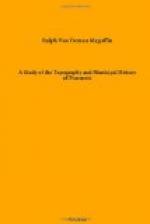[Footnote 40: C.I.L., XIV., 3029; Ped XXC. Nibby, Analisi, II, p. 497, mentions an inscription, certainly this one, but reads it Ped XXX, and says it is in letters of the most ancient form. This is not true. The letters are not so very ancient. I was led by his note to examine every stone in the cyclopean wall around the whole city, but no further inscription was forthcoming.]
[Footnote 41: This stretch of opus incertum is Sullan reconstruction when he made a western approach to the Porta Triumphalis to correspond to the one at the east on the arches. This piece of wall is strongly made, and is exactly like a piece of opus incertum wall near the Stabian gate at Pompeii, which Professor Man told me was undoubtedly Sullan.]
[Footnote 42: Marucchi, Guida Arch., p. 19, who is usually a good authority on Praeneste, thinks that all the opus quadratum walls were built as surrounding walls for the great sanctuary of Fortuna. But the facts will not bear out his theory. Ovid, Fasti VI, 61-62, III, 92; Preller, Roem. Myth., 2, 191, are interesting in this connection.]
[Footnote 43: I could get no exact measurements of the reservoir, for the water was about knee deep, and I was unable to persuade my guides to venture far from the entrance, but I carried a candle to the walls on both sides and one end.]
[Footnote 44: At some places the concrete was poured in behind the wall between it and the shelving cliff, at other places it is built up like the wall. The marks of the stones in the concrete can be seen most plainly near Porta S. Martino (Fernique, Etude sur Preneste, p. 104, also mentions it). The same thing is true at various places all along the wall.]
[Footnote 45: Fernique, Etude sur Preneste, p. 107, has exact measurements of the walls.]
[Footnote 46: Fernique, Etude sur Preneste, p. 108, from Cecconi, Storia di Palestrina, p. 43, considers as a possibility a road from each side, but he is trying only to make an approach to the temple with corresponding parts, and besides he advances no proofs.]
[Footnote 47: There seems to have been only a postern in the ancient wall inside the present Porta del Sole.]
[Footnote 48: Many feet of this ancient pavement were laid bare during the excavations in April, 1907, which I myself saw, and illustrations of which are published in the Notizie d. Scavi, Ser. 5, 4 (1907), pp. 136, 292.]
[Footnote 49: Marucchi, Guida Arch., p. 57 ff. for argument and proof, beginning with Varro, de I. 1. VI, 4: ut Praeneste incisum in solario vidi.]
[Footnote 50: Cecconi, Storia di Palestrina, p. 43.]
[Footnote 51: The continuation of the slope is the same, and the method of making roads in the serpentine style to reach a gate leading to the important part of town, is not only the common method employed for hill towns, but the natural and necessary one, not only in ancient times, but still today.]




